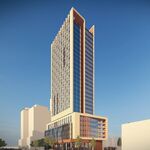jaycola
Active Member
In November last year, the first Bus only transitway opened up between Dufferin and Keele. Intended to speed the trip from Downsview Subway to York University, the 6 KM transitway costsomewhere between $30-$40 million to construct.
The project appears to be a success with transit times reduced significantly and potential capacity increased.
In the Map below, I have outlined some of the major hydro corridors which span the northern part of the city along with a couple routes which intersect the subway at it's outer edges.
Assuming that the cost to construct a bus only transitway at around $5 million per KM, could this not be a cost effective option to move large numbers of people across the city, taking pressure off of the roadways and subway system?
 See the map on googlemaps
See the map on googlemaps
The project appears to be a success with transit times reduced significantly and potential capacity increased.
Source: Spacingtoronto.caTravel times of the 196 have improved significantly, at least on paper. Less buses are providing faster and more frequent service. A service summary from before the completion of the busway required 20 buses for the morning rush on the main 196A branch (Downsview station to York U), every 2 minutes, 15 seconds, with an average speed of 23.3 km/h. In November 2009, 16 buses, running every 2 minutes even, now have an average speed of 32.8 km/h.
In the Map below, I have outlined some of the major hydro corridors which span the northern part of the city along with a couple routes which intersect the subway at it's outer edges.
Assuming that the cost to construct a bus only transitway at around $5 million per KM, could this not be a cost effective option to move large numbers of people across the city, taking pressure off of the roadways and subway system?





